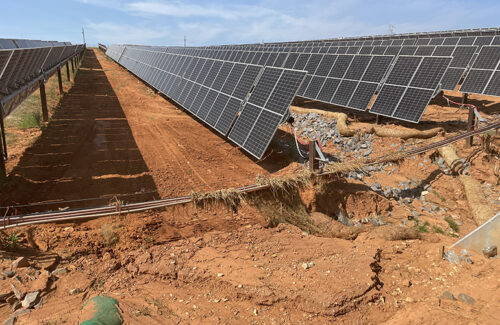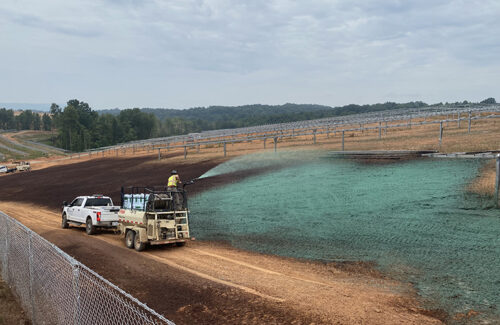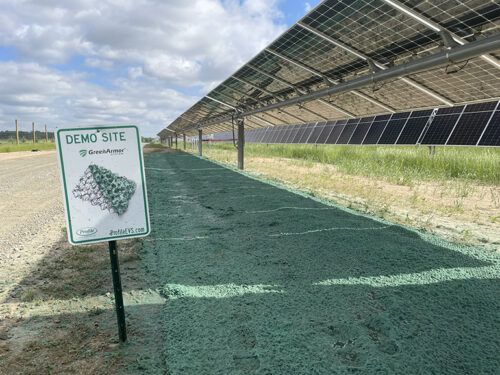
Reduce soil health and erosion risks of large-scale solar projects in public utilities
This is where data analysis and proactive, normative planning come into play. Profile Products is an agricultural solutions company that has researched tens of thousands of current and potential solar sites to analyze and evaluate their soil health and erosion risks, providing insights that can help stakeholders develop targeted mitigation strategies.
Industry Status
This analysis was conducted using a tool called PV-IMPACTS, which represents a comprehensive mitigation plan for climate, terrain, and soil assessment. The software evaluated over ten geographic spatial factors of 13900 existing and potential solar project locations nationwide, showing that nearly 48% of solar projects (covering over 323000 acres) were classified as projects at risk of soil health issues. Poor soil health can lead to poor vegetation growth, thereby increasing the risk of erosion.

In addition to soil health risks, the software also found that 29% of these projects are at risk of erosion. This is equivalent to over 294000 acres of land potentially experiencing severe erosion, leading to potential rainwater violations and project delays, thereby affecting the sustainability of solar energy projects. Due to the fact that solar installations typically require large areas of land and stable infrastructure, the dual threats of deteriorating soil health and erosion pose significant challenges to the industry.
Dealing with risks
Developers need to consider the interrelated regulatory, environmental, economic, and public awareness risks associated with not actively addressing soil health and erosion issues.
From a regulatory perspective, maintaining soil health and controlling erosion are crucial for complying with environmental standards. Solar installations are typically subject to strict regulations that require the adoption of sustainable land management practices. Projects that do not meet these standards may face penalties, expensive corrective measures, and long-term reputation damage, which may hinder future development opportunities. Ensuring compliance from the outset through active soil management can protect developers from unexpected fines and create simplified pathways for project approval.
Developers also need to consider environmental risks. If not managed properly, erosion may result in significant project delays due to necessary reclassification or replanting, thereby increasing costs and potentially affecting the entire project timeline. Poor soil conditions and subsequent vegetation growth failures not only disrupt the stability of the site, but also damage the environmental integrity of the project, which may lead to sediment runoff into nearby ecosystems, thereby affecting water quality and local wildlife habitats.

Public awareness and community relations also play an important role in the success of solar energy projects. Solar energy development, especially in rural or agricultural areas, can affect surrounding communities who may be sensitive to land management practices. Failed vegetation construction or obvious erosion issues may damage public trust and lead to potential resistance to current or future projects.
In addition, developers also have the opportunity to improve local agricultural productivity and further strengthen community relationships by introducing local species to establish favorable habitats for pollinators around solar energy sites. Pollinating insects such as bees and butterflies are crucial for food production. Establishing such habitats on large-scale solar projects can increase the yield of nearby farms and is expected to bring $63.9 million in agricultural productivity and economic benefits annually.
Hydraulic seeding as a solution
Once these risks are identified, it is crucial to implement standardized soil management strategies. One of the most practical and effective methods to reduce erosion and poor soil health is hydraulic seeding. Hydraulic seeding is a technique of spraying a slurry mixture of seeds, fertilizers, soil reinforcement additives, and water onto a large area to promote rapid vegetation growth and stabilize the soil.
The main advantage of hydraulic seeding is the ability to quickly establish vegetation, which is crucial for controlling erosion. When vegetation takes root, its roots help to bond the soil and prevent it from being washed away during rainfall or wind events. Hydraulic coverings can capture moisture, regulate soil temperature, and act as a protective layer, reducing the impact of surface runoff and preventing further soil degradation.
Many contractors enhance soil health by incorporating biological soil media products into their hydraulic seeding plans. These products introduce beneficial microorganisms and organic matter into the soil. These elements enhance nutrient utilization, promote stronger root development, promote overall ecosystem health, and thus establish vegetation faster and more sustainably. Experts suggest conducting soil testing to determine which soil health additives (if any) may be needed at the location.

Hydraulic seeding is particularly suitable for solar energy sites, which typically cover large brownfields or retired agricultural sites, as well as uneven terrain that hinders vegetation due to nutrient deficiencies. Hydraulic seeding can quickly cover large areas, making it an ideal and cost-effective solution for large-scale solar installations. The long-term reduction in maintenance costs further increases its value, making it an economically viable solution for solar developers seeking to manage erosion and improve soil health.
The expansion of solar energy is crucial for achieving renewable energy goals, but environmental management must be kept in mind. By identifying risks early and using best management practices to restore and protect land, solar developers can effectively alleviate these challenges.
© Derechos de autor: 2025 Xiamen Wintop New Energy Tech Co., Ltd.. Reservados todos los derechos.

Compatible con red IPv6